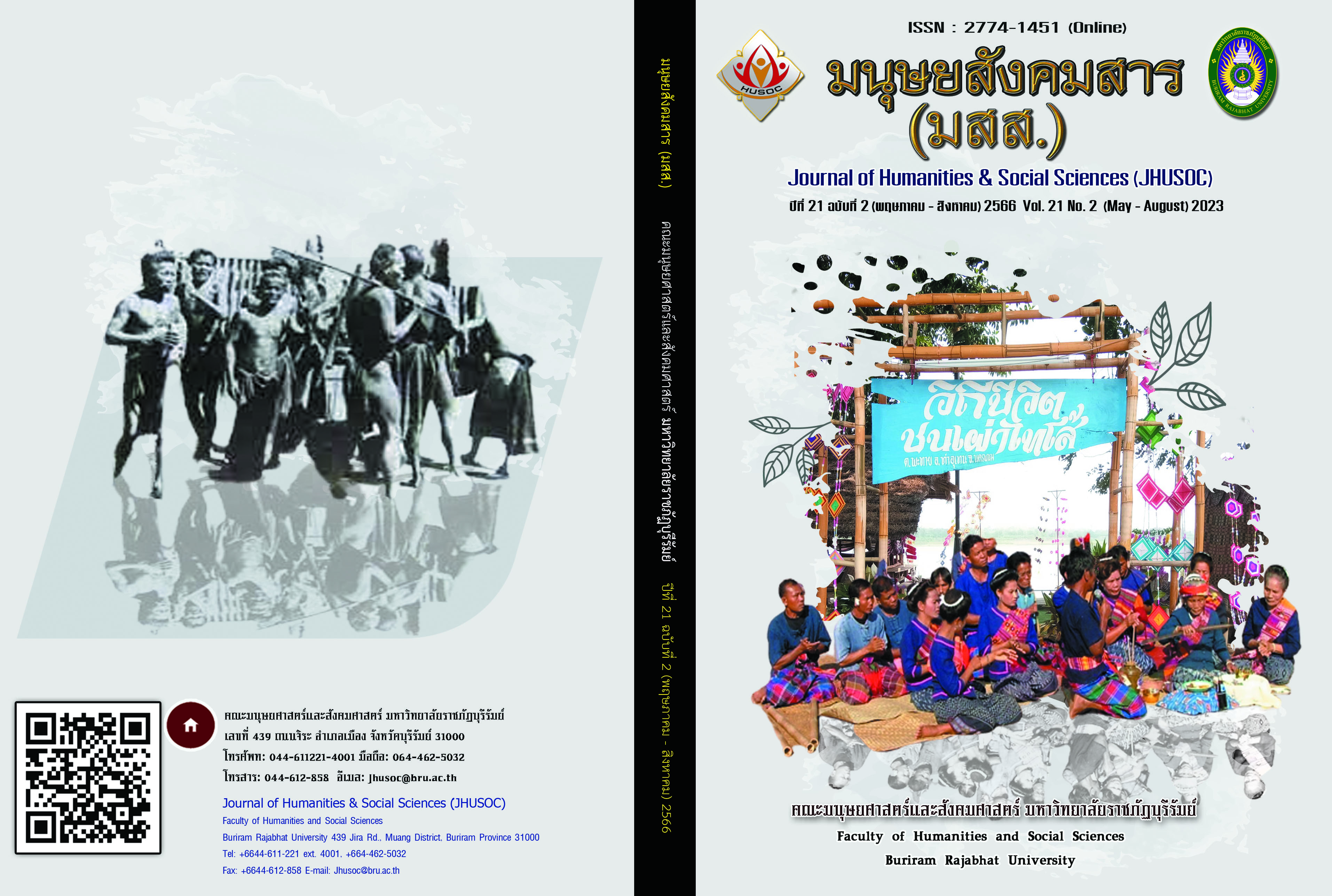การปรับตัวทางสังคมวัฒนธรรมของกลุ่มชาติพันธุ์โส้ในบริบทสังคมอีสาน
Main Article Content
บทคัดย่อ
บทความนี้มีวัตถุประสงค์เพื่อศึกษาการปรับตัวทางสังคมวัฒนธรรมของกลุ่มชาติพันธุ์โส้ในบริบทสังคมอีสาน เป็นงานวิจัยเชิงคุณภาพ โดยการสัมภาษณ์ผู้ให้ข้อมูลสำคัญ จำนวน 74 คน ด้วยวิธีการคัดเลือกแบบเจาะจง นำข้อมูลมาวิเคราะห์ และนำเสนอด้วยรูปแบบการวิจัยเชิงพรรณนาวิเคราะห์ ผลการวิจัยพบว่า กลุ่มชาติพันธุ์โส้อยู่ในกลุ่มตระกูลภาษาออสโตรเอเชียติก (Autro-Asiatic) สาขามอญ-เขมร หรือกะตูอิก (Katuic) มีความเชื่อเรื่อง “ผี” ทำหน้าที่เป็นกรอบกำกับพฤติกรรมและความสัมพันธ์ของสมาชิกในกลุ่มที่มีความแตกต่างจากกลุ่มชาติพันธุ์อื่น ในบริบทสังคมอีสานกลุ่มชาติพันธุ์โส้ปรับเปลี่ยนวิถีชีวิต สังคมวัฒนธรรมให้เข้ากับท้องถิ่นอีสานได้อย่างกลมกลืน เลือกใช้ภาษาสลับกันไปมาอย่างเลื่อนไหลทั้งความเป็นโส้และความเป็นท้องถิ่นอีสาน มีการปรับตัวทางวัฒนธรรมเพื่อการท่องเที่ยว หยิบเลือกใช้กลยุทธ์ทางวัฒนธรรมหลายแบบเพื่อรับมือกับวัฒนธรรมกระแสหลักในท้องถิ่นอีสาน กลยุทธ์ที่สำคัญคือ การถือผีควบคู่ไปกับการนับถือพุทธศาสนา โดยปรับเปลี่ยนตำแหน่งผีสูงสุดเป็นผีปู่ตาตามแบบวัฒนธรรมท้องถิ่นอีสาน ขณะเดียวกันก็เลือกที่จะรักษาและประดิษฐ์สร้างมิติวัฒนธรรมอย่างอื่นของความเป็น “โส้” เพื่อรักษาความมีตัวตนทางวัฒนธรรมให้คงอยู่ โดยไม่ถูกกลืนกลายด้วยวัฒนธรรมกระแสหลัก แสดงให้เห็นถึงศักยภาพในการปรับตัวให้เข้ากับวัฒนธรรมกระแสหลักได้อย่างกลมกลืน
Article Details

อนุญาตภายใต้เงื่อนไข Creative Commons Attribution-NonCommercial 4.0 International License.
เนื้อหาและข้อมูลในบทความที่ลงตีพิมพ์ในวารสารทดสอบระบบ ThaiJo2 ถือเป็นข้อคิดเห็นและความรับผิดชอบของผู้เขียนบทความโดยตรงซึ่งกองบรรณาธิการวารสาร ไม่จำเป็นต้องเห็นด้วย หรือร่วมรับผิดชอบใดๆ
บทความ ข้อมูล เนื้อหา รูปภาพ ฯลฯ ที่ได้รับการตีพิมพ์ในวารสารทดสอบระบบ ThaiJo2 ถือเป็นลิขสิทธิ์ของวารสารทดสอบระบบ ThaiJo2 หากบุคคลหรือหน่วยงานใดต้องการนำทั้งหมดหรือส่วนหนึ่งส่วนใดไปเผยแพร่ต่อหรือเพื่อกระทำการใดๆ จะต้องได้รับอนุญาตเป็นลายลักอักษรจากวารสารทดสอบระบบ ThaiJo2 ก่อนเท่านั้น
เอกสารอ้างอิง
Bangperng, K. (2022). The dynamics of Kha-phrakaew identity in the context of Thai-Lao History and Politics. Manusaya: Journal of Humanities, 25(1), 1-19. [in Thai]
Burasith, Y. (2009). Encyclopedia of ethnic groups in Thailand: So Nakhon Pathom: Language and Culture Research Institute for Rural
Development Mahidol University. [in Thai]
Chantawanich, S. (2002). Qualitative research methods (11th ed.). Bangkok: Chulalongkorn University Press. [in Thai]
Dhampunta, S. (2010). Man and society (2nd ed.). Bangkok: Phoom Thai.[in Thai]
Faengsidam, S. (1999). Taikrua: Cultural assimilation in a case study of Ban Dong Suan Pattana. Nathan Sub-disstrict, Kham Muang District, Kalasin Province (M.A. Thesis). Maha Sarakham: Mahasarakham Unviersity. [in Thai]
Failai, T. (2019). The Thai So ethnic group in the Sakon Nakhon Basin. Journal of Graduate School, 16(74), 225-234. [in Thai]
Malesevic, S. (2011). Ethnicity in time and space: A conceptual analysis.https://www.cur.sagepub.com.
Pontri, K. (1984). The cultural assimilation of the So ethnic group with the culture of the Northeast: A case study Kusuman and Pho Phaisarn sub-district, Kusuman District, Sakon Nakhon Province (M.A. Thesis). Bangkok: Kasetsart University. [in Thai]
Pongsapich, A. (1998). Culture, religion, ethnicity: An anthropological analysis of Thai society (5th ed.). Bangkok: Chulalongkorn University Press. [in Thai]
Soonthornpasuch, S. (2005). Isaan village in the cold war era: Sociology of northeastern villages. Bangkok: Ngarn Dee. [in Thai]
Suphon, S. (1990). The worldview of So ethnic group: The case of Ban Nong Yang Chanod Noi Sub-district, Luang District, Mukdahan Province (M.A. Thesis). Maha Sarakham: Srinakharinwirot University. [in Thai]


